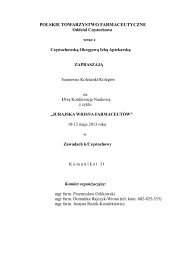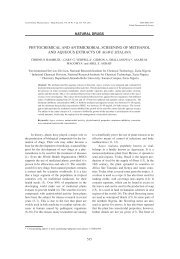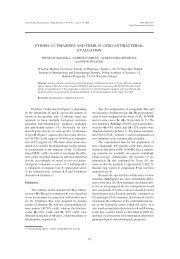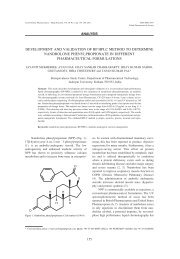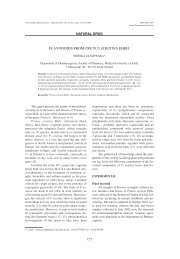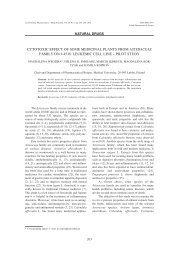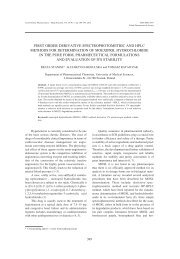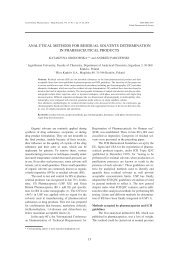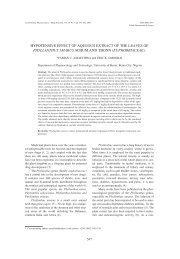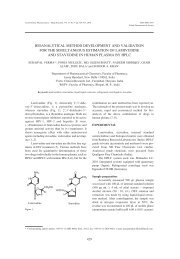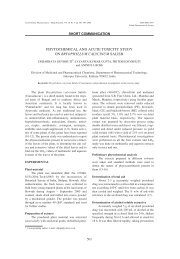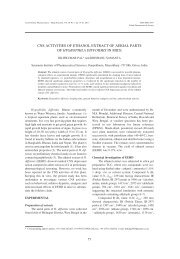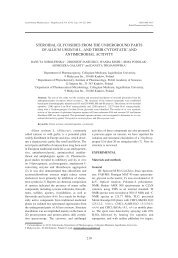Postępy w farmakoterapii cukrzycy typu 2 i chorób układu sercowo ...
Postępy w farmakoterapii cukrzycy typu 2 i chorób układu sercowo ...
Postępy w farmakoterapii cukrzycy typu 2 i chorób układu sercowo ...
You also want an ePaper? Increase the reach of your titles
YUMPU automatically turns print PDFs into web optimized ePapers that Google loves.
6. Szymborska-Kajanek, Szendzielorz-Honisz K.: Patogeneza późnych<br />
powikłań cukrzycowych. W: Diabetologia (Red.) Strojek K, Wydawnictwa<br />
Medyczne Termedia, Poznań 2008.<br />
7. Polskie Towarzystwo Diabetologiczne. Zalecenia kliniczne dotyczące<br />
postępowania u chorych na cukrzycę 2007. Diabetol. Prakt. 2007,<br />
8 (supl. A), S13.<br />
8. Fowler M.J.: Leczenie <strong>cukrzycy</strong>, część 2: Doustne leki hipoglikemizujące.<br />
Diabetologia po Dyplomie, 5 (2), 65–72.<br />
9. Kozek E.: Zasady leczenia <strong>cukrzycy</strong> <strong>typu</strong> 2. Terapia, 2007, 15, 5 (193), 21–27.<br />
10. Czech A., Grzeszczak W., Gumprecht J. i wsp.: Zalecenia dotyczące<br />
postępowania u chorych na cukrzyce 2007. Stanowisko Polskiego<br />
Towarzystwa Diabetologicznego. Medycyna Praktyczna 2007/04.<br />
11. Knowler W.C., Barrett-Connor E., Fowler S. E. i wsp.: Reduction in the<br />
incidence of type 2 diabetes with lifestyle intervention or metformin.<br />
N. Engl. J. Med., 2002, 346, 393–403.<br />
12. Nathan D.M., Buse J.B., Davidson M.B. i wsp.: Medical Management of<br />
Hyperglycemia in Type 2 Diabetes: A Consensus Algorithm for the Initiation<br />
and Adjustment of Therapy. Diabetes Care, 2008, 31 (12), 1–11.<br />
13. The Task Force on Diabetes and Cardiovascular Diseases of the European<br />
Society of Cardiology (ESC) and of the European Association<br />
for the Study od Diabetes (EASD). Guidelines on diabetes, prediabetes,<br />
and cardiovascular diseases: executive summary. Eur. Heart J.<br />
2007, 28, 88–136.<br />
14. Nathan D.M., Buse J.B., Davidson M.B.. i wsp.: Medical management<br />
of hyperglycemia in type 2 diabetes mellitus: a consensus algorithm<br />
for the initiation and adjustment of therapy. A consensus statement<br />
from the American Diabetes Association and the European Assiociation<br />
for the Study of Diabetes. Diabetes Care, 2009, 32, 193–203.<br />
15. Skyler J.S., Bergenstal R., Bonow R.O. i wsp.: Intensive Glycemic Control<br />
and the Prevention of Cardiovascular Events: Implications of the<br />
ACCORD, ADVANCE, and VA Diabetes Trials: A position Statement of<br />
the American Diabetes Association and a Scientific Statement of the<br />
American College of Cardiology Foundation and the American Heart<br />
Association. Circulation, 2009, 119, 351–357.<br />
16. UK Prospective Diabetes Study (UKPDS) Group: Effect of intensive<br />
blood glucose control with metformin on complication in overweight<br />
patients with type 2 diabetes (UKPDS 34), Lancet, 1998, 352,<br />
854–865.<br />
17. UK Prospective Diabetes Study (UKPDS) Group: Intensive blood glucose<br />
control with sulphonylureas or insulin compared with conventional<br />
treatment and risk of complication in patients with type 2 diabetes<br />
(UKPDS 33). Lancet 1998, 352, 837–853.<br />
18. Grzeszczak W., Gumprecht J.: Pochodne sulfonylomocznika, Wydawnictwo<br />
Medyczne Via Medica, Gdańska 2004.<br />
19. Schernthaner G., Grimaldi A., Di Mario U. i wsp.: GUIDE study: double-blind<br />
comparison of once daily gliclazide MR and glimepiride<br />
in type 2 diabetes patients. Eur. Clin. Invest. 2004, 34, 535–542.<br />
20. The ADVANCE Collaborative Group: Effects of intensiva blond glucose<br />
control and vascular outcomes in patients with type 2 diabetes.<br />
N. Engel. J. Med. 2008, 358, 2560–2572.<br />
21. Klupa T., Trznadel-Morawska I., Sieradzki J.: Jak zapobiegać naczyniowym<br />
powikłaniom <strong>cukrzycy</strong> <strong>typu</strong> 2? Omówienie założeń i wyników<br />
438<br />
ramienia hipoglikemizujacego badania ADVANCE. Diabet. Prakt.<br />
2008, 9, 103–112.<br />
22. Katra B.: Zastosowanie pochodnych sulfonylomocznika. Terapia,<br />
2007, 15, 5 (193), 28–32.<br />
23. Sieradzki J.: Inhibitory alfa-glukozydaz. Terapia, 2007, 15, 5 (193), 35–40.<br />
24. Lincoff A.M., Wolski K., Nicholls S.J. i wsp.: Pioglitazone and risk<br />
of cardiovascular events in patients with type 2 diabetes mellitus:<br />
a meta-analysis of randomized trials. JAMA, 2007, 298, 1180–1188<br />
25. Nissan S.E., Wolski K.: Effect of rosiglitazone on the risk of myocardial<br />
infarction and death from cardiovascular causes. N. Engl. J.<br />
Med., 2007, 356, 2457–2471.<br />
26. Psaty B.M., Furberg C.D.: The record on rosiglitazone and the risk of<br />
myocardial infarction. N. Engl. J. Med., 2007, 357, 67–69.<br />
27. Schwarz A.V., Sellmeyer D.E., Vittinghoff E. i wsp.: Thiazolidinedione<br />
use and bone loss in older diabetic adults. J. Clin. Endocrinol. Metab.,<br />
2006, 91, 3349–3354.<br />
28. Wróbel M., Szymborska-Kajanek A., Psurek A. i wsp.: Zastosowanie<br />
preparatów poprawiających efekt inkretynowy w leczeniu <strong>cukrzycy</strong><br />
<strong>typu</strong> 2. Przew. Lek. 2008, 3, 24–31.<br />
29. Schmitz O., Brock B., Rugby J.: Amylin agonists: a novel approach<br />
in the treatment of diabetes. Diabetes 2004, 53 (Suppl. 3),<br />
S233–S238.<br />
30. Sieradzki J.: Współczesna insulinoterapia. Terapia, 2007, 15, 5 (193),<br />
46–52.<br />
31. Strojek K.: Insulinoterapia. W: Diabetologia (Red.) Strojek K, Wydawnictwa<br />
Medyczne Termedia, Poznań 2008.<br />
32. Tatoń J., Czech A. (Red): Diabetologia. T. 1 i T. 2. PZWL, Warszawa<br />
2001.<br />
33. Tatoń J., Czech A., Bernas M.: Charakterystyka cukrzycowych <strong>chorób</strong><br />
serca oraz mechanizmów aterogenezy. W: Cukrzycowe choroby<br />
serca. Nowa wiedza – nowe leczenie. (red.) Tatoń J., Czech A., Opolski<br />
G., Zembala A., Via Medica, Gdańsk 2005.<br />
34. Krentz A.J.: Lipoproteid abnormalities and their consequences for<br />
patients with Type 2 diabetes. Diabetes, Obesity and Metabolism,<br />
2003, 5(Suppl.1), S19–S27.<br />
33. Holland R.D., Mycek M.J.: Pharmacology, 3rd edition. Ed. Harvey R.A.,<br />
Champe P.C. Lippincott Williams & Wilkins. Philadelphia-Baltimore-<br />
New York, 2006.<br />
34. Sarafidis P.A., Bakris G.L.: Antihypertensive therapy and the risk of<br />
New-onset diabetes. Diabetes Care, 2006, 29, 1167–1169.<br />
35. Kozek E.: Postępowanie w nadciśnieniu tętniczym u chorych na cukrzycę,<br />
Terapia 2004, 12, 5, z.1 (151), 26–32.<br />
36. Thurman J.M., Schrier R.W.: Comparative effects of angiotensin-converting<br />
enzyme inhibitors and angiotensin receptor blockers on<br />
blood pressure and the kindey. Am. J. Med. 2003, 114, 588.<br />
37. ASH Position Paper: Treatment of hypertension in patients with diabetes<br />
– an update. J. Clin. Hypert., 2008, 10, 707–713.<br />
38. Thurman J. M., Schrier R. W.: Comparative effects of angiotensin-converting<br />
enzyme inhibitors and angiotensin receptor blockers on blood<br />
pressure and the kindey. “Am. J. Med.” 2003, 114, 588<br />
39. ASH Position Paper: Treatment of hypertension in patients with diabetes<br />
– an update. J. Clin. Hypert., 2008, 10, 707-713<br />
Tom 65 · nr 6 · 2009



